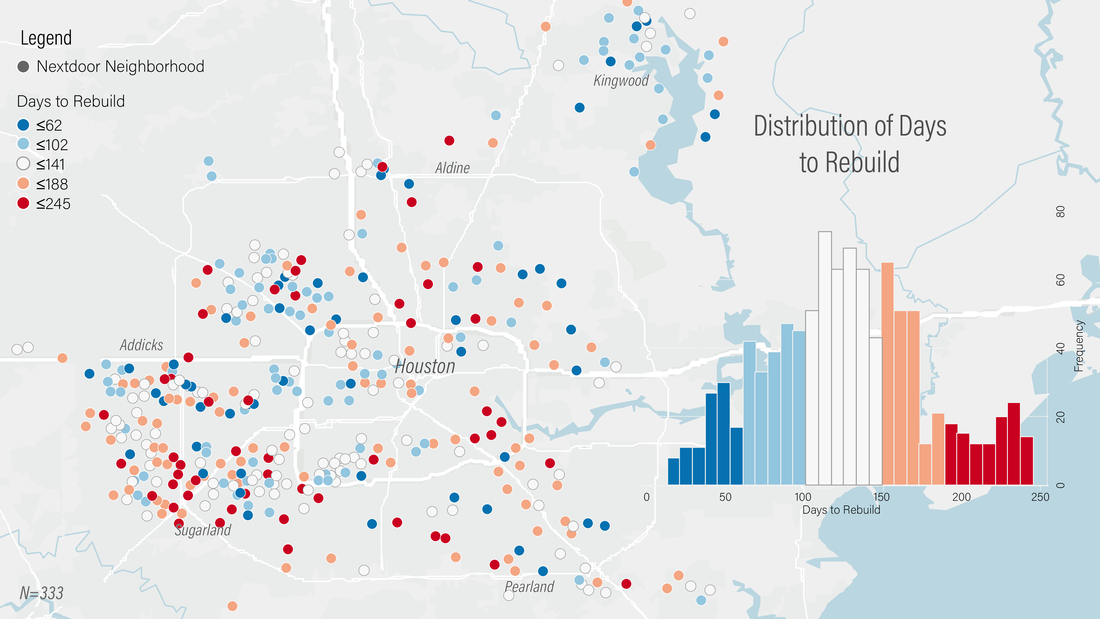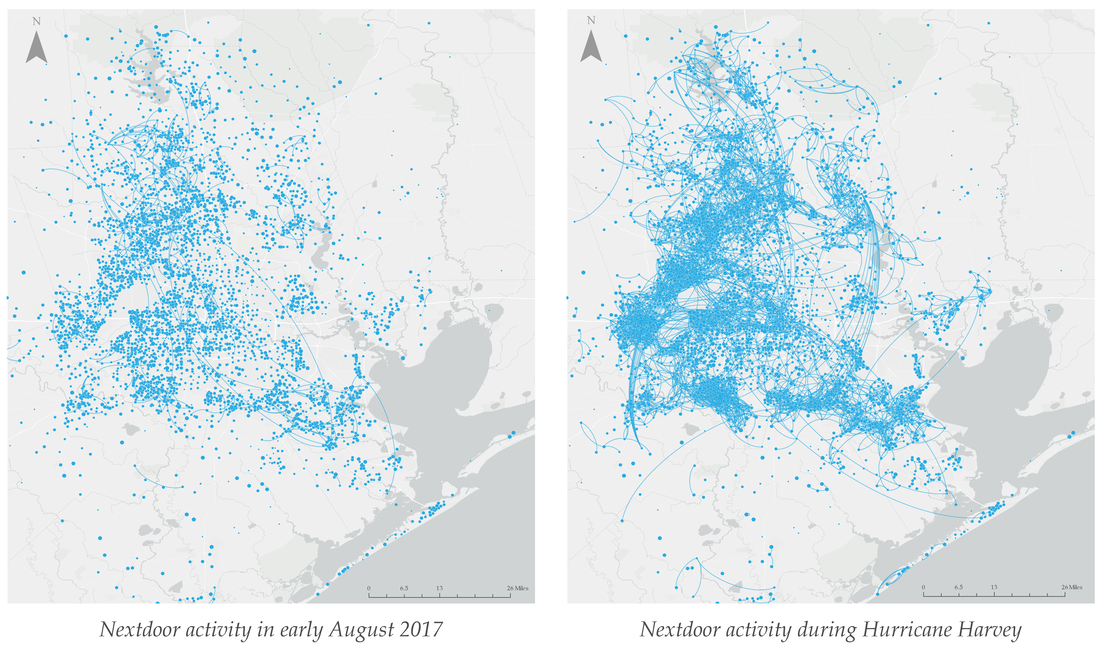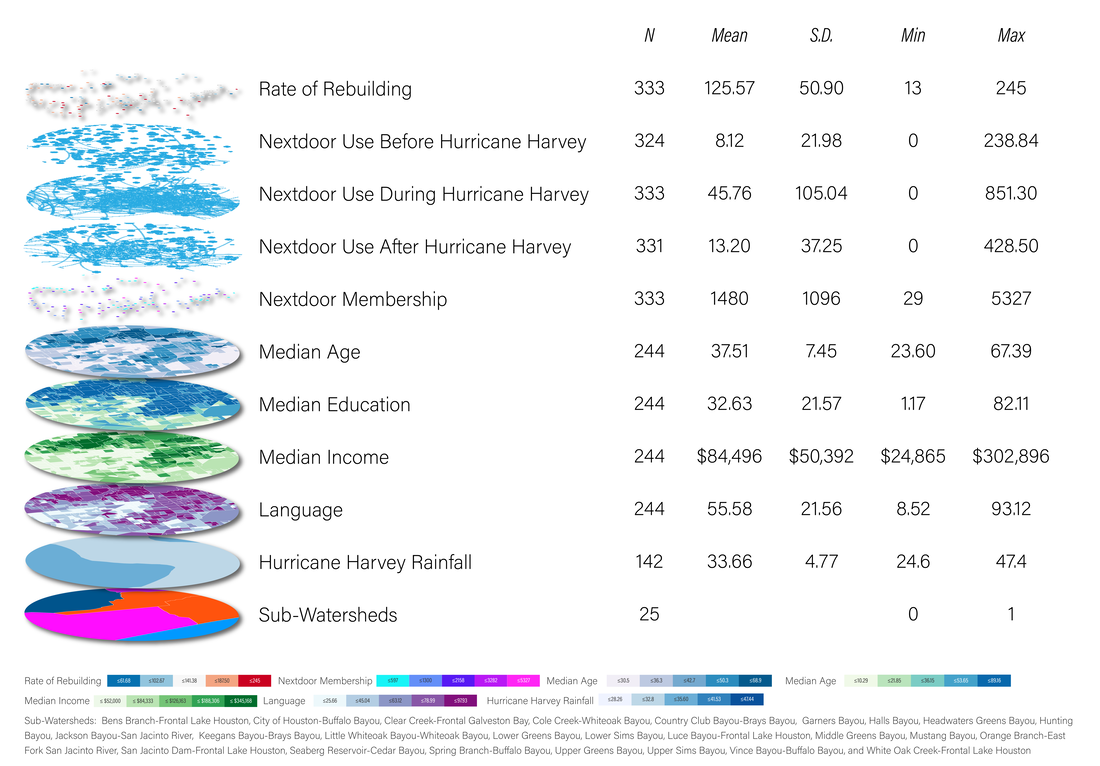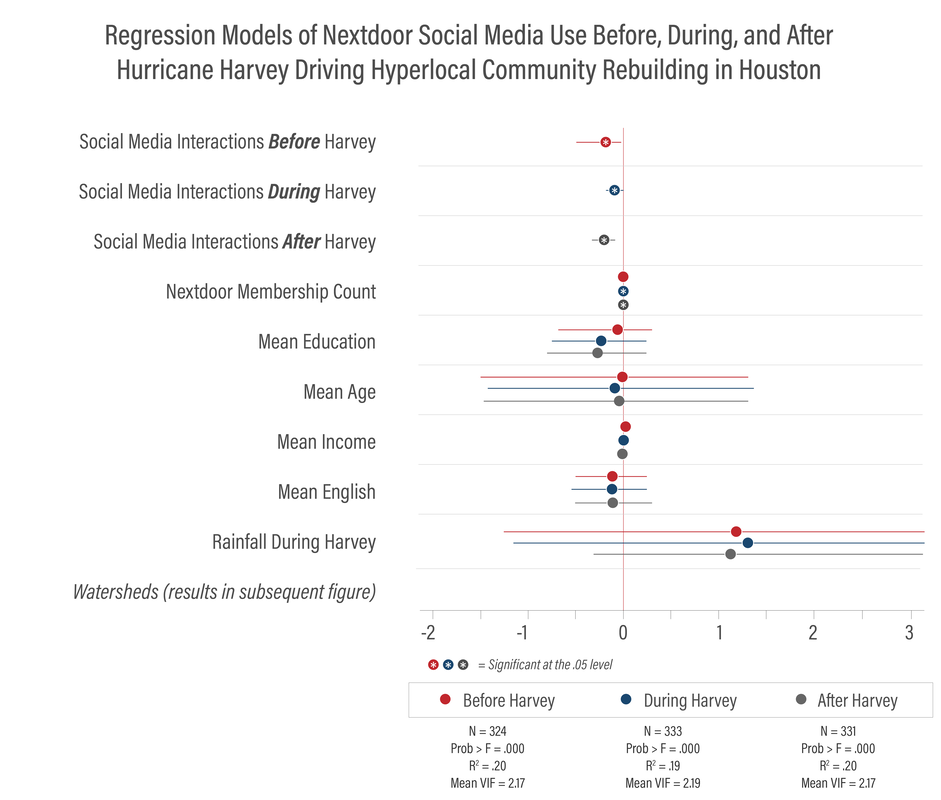- Snowed in? Social and transportation networks in the 2015 Boston Snowmageddon (Forthcoming)
- Bonding, bridging, and linking social capital and social media use: How hyperlocal social media platforms serve as a conduit to access and activate bridging and linking ties in a time of crisis (Natural Hazards)
- The role of social media in disaster recovery following Hurricane Harvey (Journal of Homeland Security and Emergency Management)
- A Janus-faced resource: Social capital and resilience trade-offs (IRGC resource guide on resilience)
Snowed In?
Social and Transportation Networks in the 2015 Boston Snowmageddon
Forthcoming
Abstract
Continuous subzero temperatures and an unrelenting Polar vortex turned the 2014-2015 Boston winter into a compound disaster, causing deaths and roof collapses, shutting down businesses, and paralyzing transportation networks. Little is known about the circumstances which enhanced community resilience and reduced impacts during this extended disaster. Using original surveys of more than 140 affected community members alongside demographic data from census and ESRI sources and GIS data on bus and rail networks, we investigate the factors that allowed vulnerable communities to overcome the crisis. Through mixed-methods approaches, including GIS spatial analysis, multiple regression, average treatment effects, and propensity score matching, we illuminate the factors that helped urban residents mitigate the impact of the Boston snowstorms. Controlling for a number of potential confounding variables, including demographic and economic factors and transportation access, we find that bonding social ties served as a significant mitigating force during the crisis. These findings bring with them important public policy findings for residents, NGOs, and decision-makers alike as we struggle to adapt to extreme weather events amidst increasing urbanization.
Abstract
Continuous subzero temperatures and an unrelenting Polar vortex turned the 2014-2015 Boston winter into a compound disaster, causing deaths and roof collapses, shutting down businesses, and paralyzing transportation networks. Little is known about the circumstances which enhanced community resilience and reduced impacts during this extended disaster. Using original surveys of more than 140 affected community members alongside demographic data from census and ESRI sources and GIS data on bus and rail networks, we investigate the factors that allowed vulnerable communities to overcome the crisis. Through mixed-methods approaches, including GIS spatial analysis, multiple regression, average treatment effects, and propensity score matching, we illuminate the factors that helped urban residents mitigate the impact of the Boston snowstorms. Controlling for a number of potential confounding variables, including demographic and economic factors and transportation access, we find that bonding social ties served as a significant mitigating force during the crisis. These findings bring with them important public policy findings for residents, NGOs, and decision-makers alike as we struggle to adapt to extreme weather events amidst increasing urbanization.
Citation: Page-Tan, C. and Aldrich, D.P. (forthcoming) Snowed in? An Analysis of social and transportation networks in the 2015 Boston Snowmageddon. Sustainable Development.
Bonding, bridging, and linking social capital and social media use:
How hyperlocal social media platforms serve as a conduit to access and activate bridging and linking ties in a time of crisis
Abstract
Social media is changing the narrative during crisis events. It has facilitated citizen-led emergency dispatch and rescue, information sharing and communication between loved ones in the moments before, during and after a disaster. Researchers of social capital have found that bonding, bridging, and linking social capital can lead to resilient outcomes. With increased use of social media on a day-to-day basis and during a crisis, we still know little about the association between social capital and online social media use. Controlling for demographic characteristics and earthquake intensity, I investigate the association bonding, bridging and linking social capital and hyperlocal social media use following the earthquake and its aftershocks. Using a quantitative cross-sectional longitudinal study across 121 Nextdoor online neighborhoods in California’s Napa Valley region across 42 days in August and September of 2014 (N = 3570), I find that bridging and linking social capital led to more online communication via Nextdoor. This finding comes with an important implication, namely, that social media can serve as a primary source of recourse for individuals and communities following a disaster. Social media platforms provide a conduit for accessing and activating bridging and linking ties that can expedite collective action in a time of need. Communities should consider policies that increase levels of social capital, well as social media platforms that can activate social ties when they are needed most.
Social media is changing the narrative during crisis events. It has facilitated citizen-led emergency dispatch and rescue, information sharing and communication between loved ones in the moments before, during and after a disaster. Researchers of social capital have found that bonding, bridging, and linking social capital can lead to resilient outcomes. With increased use of social media on a day-to-day basis and during a crisis, we still know little about the association between social capital and online social media use. Controlling for demographic characteristics and earthquake intensity, I investigate the association bonding, bridging and linking social capital and hyperlocal social media use following the earthquake and its aftershocks. Using a quantitative cross-sectional longitudinal study across 121 Nextdoor online neighborhoods in California’s Napa Valley region across 42 days in August and September of 2014 (N = 3570), I find that bridging and linking social capital led to more online communication via Nextdoor. This finding comes with an important implication, namely, that social media can serve as a primary source of recourse for individuals and communities following a disaster. Social media platforms provide a conduit for accessing and activating bridging and linking ties that can expedite collective action in a time of need. Communities should consider policies that increase levels of social capital, well as social media platforms that can activate social ties when they are needed most.
Citation: Page-Tan, C. (2021). Bonding, bridging, and linking social capital and social media use: How hyperlocal social media platforms serve as a conduit to access and activate bridging and linking ties in a time of crisis. Natural Hazards, 1-22. https://doi.org/10.1007/s11069-020-04397-8
THE ROLE OF SOCIAL MEDIA IN DISASTER RECOVERY FOLLOWING HURRICANE HARVEY
Abstract
Hurricane Harvey was social media's first real stress test as a disaster response and recovery mechanism. A confluence of conditions makes it an ideal case study of social media's role in disaster recovery: the lack of a government-issued evacuation order, a call from government leadership for willing and able volunteers with a boat or high-water vehicle to perform life-saving rescues, and wide-spread adoption of social media platforms in the Houston area. While research on online social networks and disasters continues to grow, social scientists know little about how these online networks transform during a crisis and, further, how they drive disaster outcomes. With two original datasets, this study investigates how Houston's online social network transformed during Hurricane Harvey (2017), and the relationship between social media activity and post-Harvey recovery. The findings of a social network analysis (N= 2,387,610) and subsequent statistical analyses reveal the Houston-area online social network grew denser, clustered, and more efficient during the disaster. A spatial analysis and three separate regression models of activity before, during, and after Hurricane Harvey reveal that among 333 Nextdoor Neighborhoods, hyperlocal social media activity was a statistically significant predictor of the rate of rebuilding in these geographically based online communities. These findings suggest that policy and decision-makers should invest into online and offline hyperlocal social networks well before a disaster strikes, and leverage resources and legislation to maintain and strengthen the telecommunications and energy infrastructure that supports access to social media and telecommunications infrastructure during a time of crisis.
Hurricane Harvey was social media's first real stress test as a disaster response and recovery mechanism. A confluence of conditions makes it an ideal case study of social media's role in disaster recovery: the lack of a government-issued evacuation order, a call from government leadership for willing and able volunteers with a boat or high-water vehicle to perform life-saving rescues, and wide-spread adoption of social media platforms in the Houston area. While research on online social networks and disasters continues to grow, social scientists know little about how these online networks transform during a crisis and, further, how they drive disaster outcomes. With two original datasets, this study investigates how Houston's online social network transformed during Hurricane Harvey (2017), and the relationship between social media activity and post-Harvey recovery. The findings of a social network analysis (N= 2,387,610) and subsequent statistical analyses reveal the Houston-area online social network grew denser, clustered, and more efficient during the disaster. A spatial analysis and three separate regression models of activity before, during, and after Hurricane Harvey reveal that among 333 Nextdoor Neighborhoods, hyperlocal social media activity was a statistically significant predictor of the rate of rebuilding in these geographically based online communities. These findings suggest that policy and decision-makers should invest into online and offline hyperlocal social networks well before a disaster strikes, and leverage resources and legislation to maintain and strengthen the telecommunications and energy infrastructure that supports access to social media and telecommunications infrastructure during a time of crisis.
Citation: Page-Tan, C. (2020). The Role of Social Media in Disaster Recovery Following Hurricane Harvey. Journal of Homeland Security and Emergency Management, 18(1), 93-123. https://doi.org/10.1515/jhsem-2018-0054
A Janus-faced resource:
Social capital and resilience trade-offs
Abstract
Much research has underscored the critical role played by social capital in building resilience in communities and organizations. In a time of crisis, we know that individuals with more connections embedded in communities that are more cohesive and better connected horizontally and vertically have higher survival rates and better recoveries compared to similar individuals and locations that are less connected. Yet, a more nuanced analysis reveals resilience trade-offs between types of these social connections. This piece investigates how different types of social ties, including bonding, bridging, and linking ties, create different resilience trajectories for neighborhoods and institutions, and how they impart dynamic effects on pre-disaster neighborhood vulnerability.
Much research has underscored the critical role played by social capital in building resilience in communities and organizations. In a time of crisis, we know that individuals with more connections embedded in communities that are more cohesive and better connected horizontally and vertically have higher survival rates and better recoveries compared to similar individuals and locations that are less connected. Yet, a more nuanced analysis reveals resilience trade-offs between types of these social connections. This piece investigates how different types of social ties, including bonding, bridging, and linking ties, create different resilience trajectories for neighborhoods and institutions, and how they impart dynamic effects on pre-disaster neighborhood vulnerability.
Citation: Aldrich, D. P., Page-Tan, C., & Fraser, T. (2018). A Janus-faced resource: Social capital and resilience trade-offs. In Trump, B. D., Florin, M.-V., & Linkov, I. (Eds.). IRGC resource guide on resilience (vol. 2): Domains of resilience for complex interconnected systems. Lausanne, CH: EPFL International Risk Governance Center.






